Horse Shoe Spread
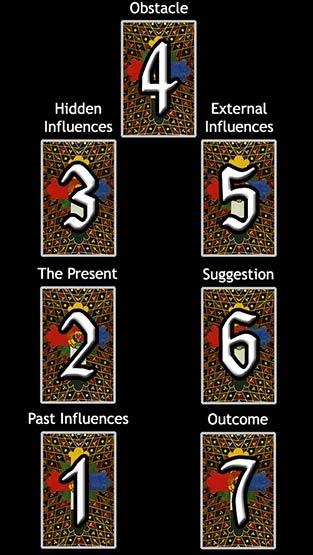
Difficulty: Easy
The Horse Shoe is a classic tarot spread. It is more advanced than the three-card reading, yet simpler than most other spreads. It is a versatile method that can be used for most queries, though there are other spreads which would go into more depth. Like the simple Past, Present, and Future spread, it contains these cards in positions #1, #2, and #7, but also has four other tarot cards that help the reader understand how to deal with the future better. The cards are to be read as follows:
- The Past: Past events affecting the question.
- The Present: The current state or approaching influence.
- Hidden Influences: Things the reader may not be aware of (or barely be aware of).
- Obstacles: This is the challenge: obstacles may be avoided or may have to be dealt with.
- External Influences: Attitudes and thoughts regarding people around the reader.
- Suggestions: Recommended course of action.
- Outcome: The result of following the suggestions.
Your Horse Shoe Reading
Obstacle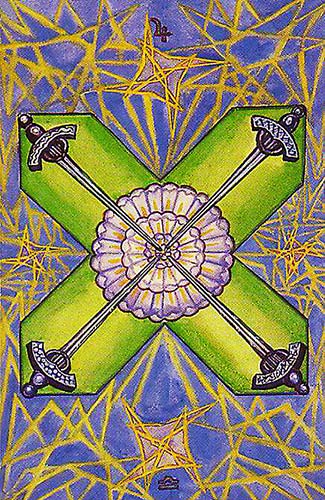 Four of Swords (Truce) |
||
Hidden Influences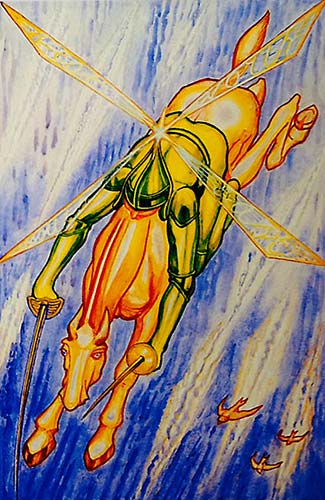 Knight of Swords |
External Influences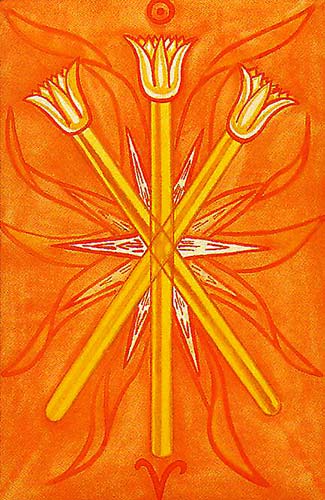 Three of Wands (Virtue) |
|
The Present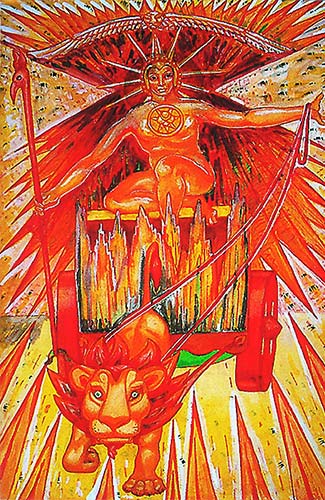 Prince of Wands |
Suggestion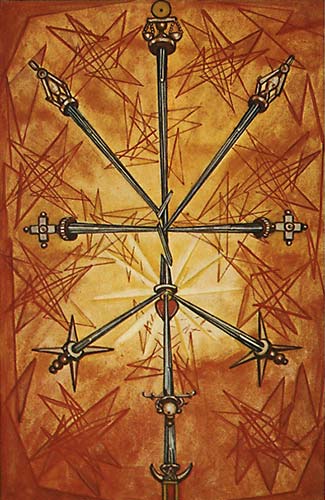 Ten of Swords (Ruin) |
|
The Past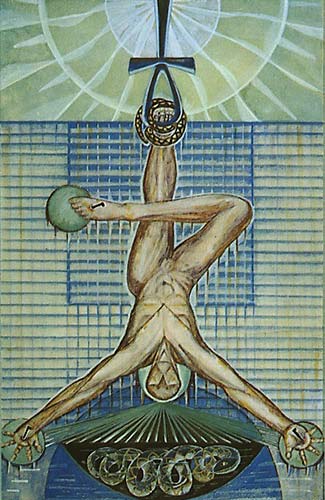 XII – The Hanged Man |
The Outcome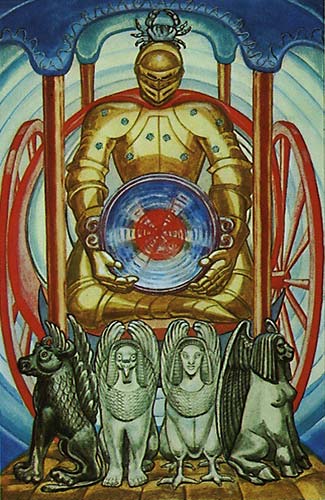 VII – The Chariot |

The Past Card represents past events that are affecting the question.
XII – The Hanged Man
(Water, Mem)
The Hanged Man represents surrender, transformation, and the wisdom gained through self-sacrifice. Associated with Mem, the waters, this card embodies the flow of unconscious depths and the mysteries that lie beyond the material world. It is not a card of suffering but one of enlightenment through letting go.
The central figure is suspended upside-down, forming a cross with his legs, a symbol of balance and sacrifice. His arms form a triangle, evoking the union of spirit and matter. Behind him, the swirling blue-green background suggests the ocean of the subconscious. The serene expression on his face reflects the tranquillity found in surrendering to a greater truth. Around him, rays of light emanate, signifying the revelation that arises from this state of suspension.
In Relationships: The Hanged Man suggests a need for patience, selflessness, and understanding. It encourages you to see things from your partner's perspective and release control.
In Work: This card indicates a period of pause or sacrifice, where immediate goals may need to be set aside for long-term growth. You are advised to trust in the process and focus on the bigger picture.
Spiritually: The Hanged Man symbolises enlightenment achieved through surrender and the release of ego. It calls you to embrace the transformative power of stillness and contemplation.
When ill-dignified: The Hanged Man warns of stagnation, resistance to change, or clinging to outdated beliefs. You are advised to let go of what no longer serves you and embrace the wisdom of surrender.

The Present Card represents the current state or immediately approaching influence.
Prince of Wands
Element: Air of Fire
Astrological Correspondence: Leo
The Prince of Wands represents the intellectual and communicative aspects of Fire, where mental energy and creative passion converge. As Air of Fire, he embodies the visionary thinker who brings dynamic ideas, plans, and strategies to life with inspiration and daring. The Prince is a passionate and courageous individual, full of bold concepts and the drive to translate them into action.
This card symbolises the spirit of adventure and enterprise, where creativity is channelled into purposeful movement. It is a card of intellectual boldness, where ideas ignite like wildfire and are swiftly translated into reality. The Prince of Wands is a figure of immense energy, filled with determination and enthusiasm to take on challenges, initiating projects with great confidence. He encourages you to embrace the power of your thoughts and ambitions, and act decisively in the pursuit of your goals.
In Relationships: The Prince of Wands represents passion and excitement. This can indicate a fast-moving romance full of desire and adventure, but it can also imply someone committed to the thrill of pursuit rather than steady emotional intimacy. The Prince is often the impulsive lover, driven by the desire for adventure or novelty.
In Work: In the professional world, the Prince of Wands is an energetic and bold leader, pushing projects forward with enthusiasm and a strong sense of purpose. He represents the catalyst for action, the one who brings ideas into motion. However, this card also warns that rushing forward without a solid plan can lead to burnout or missed opportunities.
Spiritually: The Prince of Wands can indicate intellectual exploration or philosophical inquiry. You may seek ways to expand your mind, often through bold or unconventional means. The card may also represent an energetic search for truth or personal enlightenment.
When ill-dignified: The Prince of Wands can indicate mental restlessness, hasty decisions, or an excessive focus on novelty at the expense of deeper commitment. You may be easily distracted or prone to acting on impulse without thinking through the consequences. This card warns against reckless behaviour or a lack of foresight in your actions.

Hidden Influences - Things that you may not be aware of, or barely be aware of.
Knight of Swords
Element: Fire of Air
Astrological Correspondence: Gemini
The Knight of Swords represents an intense, fast-moving force of intellect and action. He charges through the air with fierce determination, embodying the quick, forceful qualities of Air in motion. The Knight's swift movement symbolises his drive to deliver ideas and messages, pushing forward with unrelenting focus and mental energy. His actions are rapid and decisive, like a whirlwind of thought and communication, sometimes chaotic in their intensity.
This card signifies the action-oriented aspect of the Air element—taking intellectual concepts and turning them into tangible actions. However, the Knight of Swords can also represent the dangers of rushing forward without considering the consequences. His speed and energy may sometimes lead to hasty decisions or the need to reconsider the path after action has already been taken.
The Knight of Swords challenges you to embrace your intellectual power and take bold action but also reminds you of the need to temper that drive with caution, ensuring your pursuit of ideas does not lead to unintentional harm or misdirection. His energy encourages directness but warns against impatience.
In Relationships: The Knight of Swords can signify sudden and forceful communication or an intellectual attraction that dominates the emotional connection. Relationships may progress rapidly, but arguments or disagreements may also mark them if the parties involved are not careful in their approach. The Knight can indicate the need for quick, clear communication, but also suggests avoiding impulsive, hurtful words.
In Work: The Knight of Swords represents a fast-paced, intellectually driven professional environment. This is a person determined to achieve success by force of will, intellect, and swift action. However, this card can indicate that you might need to slow down and consider the consequences of your actions before you rush ahead. It's easy to become caught up in the speed of success and miss important details.
Spiritually: The Knight of Swords symbolises a quest for intellectual enlightenment, often seeking truth and knowledge through sharp analysis. This card can indicate a sudden spiritual awakening or an urge to rush towards spiritual goals but also warns that the pursuit of intellectual clarity can overshadow emotional or intuitive wisdom.
When ill-dignified: The Knight of Swords indicates impulsive, reckless behaviour driven by hasty thoughts and actions. You may rush into situations without thinking them through, leading to chaos or conflict. It's important to exercise caution and avoid becoming too forceful or aggressive in pursuing goals. This card can also point to misunderstandings or cutting words that cause damage to relationships or situations.

Obstacle - This is the challenge.
Four of Swords (Truce)
Astrological Correspondence: Jupiter in Libra
The Four of Swords represents Truce, a moment of peace after a period of mental or emotional conflict. In the Thoth imagery, the four swords converge at a central point, creating a sharp intersection over a lotus flower, symbolising balance, peace, and spiritual calm. The swords are not in active conflict but align in a way that suggests a temporary cessation of mental struggle, offering a moment for reflection and respite.
With Jupiter in Libra, this card emphasises the themes of balance, expansion, and harmonious resolution. Libra brings the need for equilibrium, and Jupiter fosters growth through peaceful cooperation. This card suggests you may find yourself in a situation where there is a pause in conflict, a moment to regain clarity and find peace within yourself before moving forward.
The Four of Swords invites you to embrace this moment of truce, allowing space for healing and reflection. The lotus flower at the centre reminds us that stillness can lead to spiritual growth and mental clarity. Though the conflict may not be resolved permanently, this pause offers an opportunity for rebalancing and gathering the strength needed for the next phase.
In Relationships: The Four of Swords can indicate a time of pause or rest. It suggests a need to take a break or step back from a situation to regain mental clarity before moving forward. It may also indicate a time of emotional healing in the relationship.
In Work: The Four of Swords suggests rest or retreat after a challenging time. It encourages you to take a mental break from stress or conflict to gain perspective and clarity before continuing. It can also indicate the need for strategic rest to re-energise and move forward with renewed focus.
Spiritually: The Four of Swords calls you to retreat and reflect. It indicates a time for meditation, contemplation, or rest to restore mental and spiritual health. The card invites you to rest from spiritual activity and allow the mind to clear, creating space for deeper insight.
When ill-dignified: The Four of Swords can indicate stagnation, withdrawal, or avoidance of necessary action. It may also suggest a refusal to rest or heal, leading to burnout or mental exhaustion. You may be using 'rest' as an excuse to avoid dealing with important issues, leading to further mental confusion or distress.

External Influences - Attitudes about this situation from people around the querent.
Three of Wands (Virtue)
Astrological Correspondence: Sun in Aries
The Three of Wands represents the harmonious alignment of will, action, and purpose. It symbolises confidence, leadership, and the strength to act with integrity. The card depicts three wands crossed in balance, radiating stability and mutual support. Flames emanate from the centre, representing the creative and dynamic energy of fire that has been focused and directed constructively.
This card is about the manifestation of one's will through effort and coordination. It marks the point where initial efforts have taken root and a solid foundation has been established, allowing for continued growth and success. Unlike the chaos of unbridled ambition, the Three of Wands reflects a disciplined and virtuous use of power, ensuring that actions align with one's higher principles. It is a card of optimism, self-assurance, and the momentum to build upon early achievements.
In Relationships: The Three of Wands indicates growth and development. The connection has reached a point where both parties can begin to see the potential for a shared future and greater commitment.
In Work: This card suggests you are beginning to see the first signs of success from previous efforts. It encourages you to continue building on their foundations and look forward to even greater accomplishments.
Spiritually: The Three of Wands represents the expansion of spiritual knowledge and understanding. It signifies progress and the beginning of a deeper connection with the divine.
When ill-dignified: The Three of Wands may suggest overconfidence, impatience, or a lack of focus. You could be spreading yourself too thin or expecting results too quickly. It advises careful planning and the need to be patient as the process unfolds.

Suggestion - The recommended course of action.
Ten of Swords (Ruin)
Astrological Correspondence: Sun in Gemini
The Ten of Swords symbolises the culmination of mental struggle and the end of a difficult intellectual phase. The card depicts ten swords arranged in the shape of the Tree of Life, illustrating the collapse of mental structures. This imagery emphasises the breakdown of old thought patterns and the finality of a challenging mental cycle.
This card represents a moment of intense closure, often following conflict, betrayal, or harsh mental realisations. However, it is not merely a card of defeat—it marks the end of a chapter and the potential for renewal. The swords' placement in the Tree of Life suggests that the end of one cycle clears the way for new understanding and growth. Though the situation may feel like a dramatic loss, it carries the seed for transformation, indicating that closure creates space for new possibilities.
In Relationships: The Ten of Swords indicates a painful end or betrayal, often one where mental or emotional abuse has occurred. It may represent the end of a toxic situation or the final straw in a relationship that has been deteriorating for some time. While painful, this card can also indicate that you are ready for closure and can now move on to new possibilities.
In Work: The Ten of Swords signifies a complete failure or collapse of a project or endeavour, often because of betrayal, poor judgement, or harsh realities. It may represent the end of a career or a job but also suggests that this ending is necessary to make way for new opportunities. It's a card of finality and transition, signalling that the worst is over.
Spiritually: The Ten of Swords represents hitting rock bottom mentally and emotionally, but also the possibility of spiritual rebirth. It signals a time when you may have suffered greatly, but this suffering can lead to deeper understanding and growth. It encourages you to release old thought patterns and embrace a fresh, transformative spiritual journey.
When ill-dignified: The Ten of Swords indicates prolonged suffering, often due to an inability to let go of mental hurts or betrayals. It suggests you may be stuck in a cycle of self-inflicted pain, unable to release negative thoughts or emotional baggage. The card warns against dwelling in despair and encourages you to recognise that the worst has passed and that renewal is possible.

The Outcome - What will happen if the suggestion is followed.
VII – The Chariot
(Cancer, Cheth)
The Chariot represents triumph through willpower, discipline, and the unification of opposing forces. Associated with Cheth, the fence, it symbolises both protection and the boundaries that define and direct progress. Cancer, the zodiac sign of emotional depth and intuition lends the card its nurturing energy, ensuring that strength is tempered with compassion.
The Charioteer is a figure of regal composure, encased in golden armour and standing within a shell-like chariot. This shell evokes the protective qualities of Cancer, while the armour signifies spiritual and emotional fortitude. In his hands, he holds the Holy Grail, a symbol of divine purpose and spiritual attainment. The four sphinxes that draw the chariot—two white and two dark—represent the dual forces of light and darkness, which the Charioteer must master to move forward. The canopy above him is adorned with stars, linking his journey to celestial guidance and higher aspirations.
In Relationships: The Chariot indicates a relationship that requires balance and mutual effort to succeed. It suggests overcoming obstacles through shared determination and a focus on common goals.
In Work: This card signifies victory achieved through discipline, focus, and the ability to steer conflicting forces towards a unified purpose. You are encouraged to remain steadfast and clear in your intentions.
Spiritually: The Chariot represents the journey of the soul towards higher awareness, guided by the alignment of will and intuition. It calls you to embrace your inner strength and move forward confidently.
When ill-dignified: The Chariot warns of a loss of direction, internal conflict, or reckless ambition. You are advised to reassess your goals and ensure you are not being led astray by conflicting desires or external pressures.